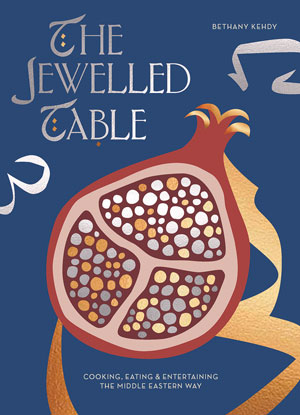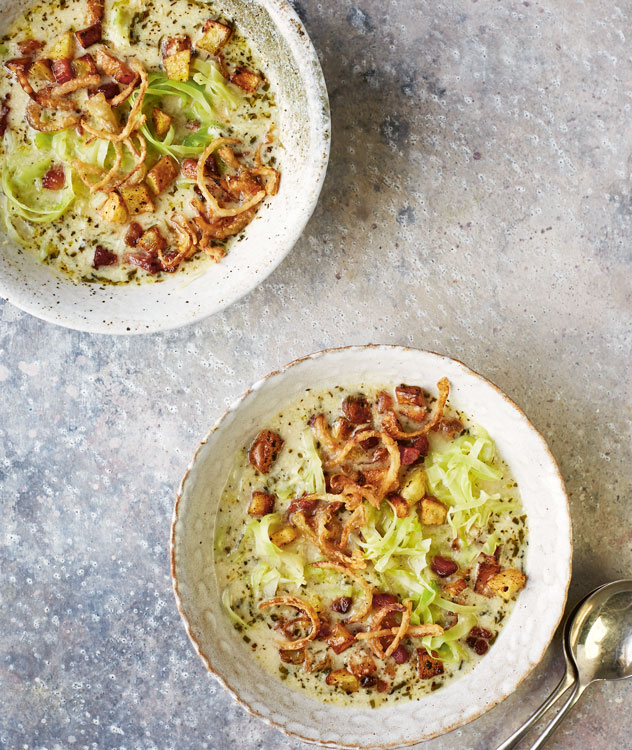Roasted Garlic Kishkeeya Soup. A millennium-old hangover cure (fit for a millennial), kishk was revered for its ‘balanced properties’ and used to make porridges known as kishkeeya in medieval Baghdad. Typically kishk soup is enjoyed for breakfast in the Levant and I can attest to its hangover zapping abilities and soul-soothing sorcery. Avoid grating or pressing the garlic, as anything that breaks down the garlic’s cells will make the soup too pungent. Traditionally, the garlic is shaved into translucent slices and slow-cooked, but as we’re often time poor (or just hungover) I have provided a passive approach, that is, baking the garlic until soft and unctuous. I prefer this method as it lends a sweetness to the resulting dish.
Serves 4–6
prep 10 minutes
cook 45 minutes
5 garlic heads, left unpeeled
1–2 tablespoons olive oil
2–3 tablespoons rapeseed oil
1 tablespoon butter
1 tablespoon dried mint
1 tablespoon finely chopped tarragon
125 g kishk flour
1 litre vegetable stock or water
flaky sea salt and freshly ground black pepper
1 potato peeled and diced
100 g Bacon basturma (recipe below) or streaky bacon (optional), roughly chopped
250 g finely shredded cabbage or other seasonal leafy green vegetable
30 g ginger, peeled and finely chopped
Tempura onions (recipe below), to garnish
Preheat the oven to 200°C. Place the garlic heads on a large sheet of foil, drizzle with the olive oil, sprinkle with salt and pepper, toss to coat and seal well. Roast in the oven for 30–40 minutes, or until the garlic is caramelised and tender. Leave it to cool slightly. Carefully unwrap the foil and squeeze the garlic flesh out of the skins. Use the edge of a knife to puree the flesh and set aside, discarding any garlic skins.
Meanwhile, place a large frying pan over medium heat and add the rapeseed oil. Add the diced potato and fry for 6–7 minutes, until browned.
Toss in the bacon basturma, if using, and cook for a further 2 minutes, then add the shredded cabbage and ginger, and stir to combine. Cook for a further 5 minutes, until the cabbage is soft. Season lightly with salt and pepper.
Place a large pan over low heat and melt the butter. Add the pureed garlic, mint and tarragon, and cook through for 1 minute. Stir in the kishk flour, along with the stock or water.
Whisk together very well, increase the heat to high and bring to the boil. Reduce the heat to low and simmer for 10 minutes, slightly covered. Season lightly with salt and pepper – the kishk flour is already salty. Divide the kishk soup between 4–6 serving bowls, spoon over the cabbage and basturma topping and finally scatter with the onion tempura.
Serve immediately.
Bacon Basturma
Basturma is a cured, heavily spiced, air-dried beef prominent in the Levant and Balkans.
makes 1.3 kg/strong>
prep 1 hour, plus curing and drying
1 kg coarse salt
600 g soft light brown sugar
1 x 2 kg boneless pork belly or beef tenderloin
for the spice paste:
55 g paprika
90 g ground fenugreek
21⁄2 tablespoons ground coriander
2 tablespoons garlic powder
3⁄4 teaspoon Aleppo pepper flakes or dried chilli flakes
3⁄4 teaspoon ground black pepper
3⁄4 teaspoon ground cumin
3⁄4 teaspoon ground allspice
In a mixing bowl, combine the salt and sugar. Line a wire rack with 3–4 sheets of greaseproof paper and place in a shallow baking tin. Add half the salt and sugar mixture to the lined rack and place the pork on top. Cover with the remaining salt and sugar mixture, making sure to thoroughly rub it into the meat. Lay another 3 sheets of greaseproof paper over the meat and weigh down with something heavy (such as a heavy book).
Transfer to the centre of the fridge (to avoid any ice, which will add moisture and therefore rot your meat), and leave to cure for 5 days. If using beef, allow to cure for 3 days. On the final day of the cure, discard the blood and rinse the meat to remove the cure.
Transfer to a large container and cover with plenty of water. Leave to soak for at least 2 hours, preferably overnight.
Remove the meat from the water and pat dry thoroughly using paper towels.
Return the meat to a clean rack secured over a baking tin, cover ever so lightly with muslin (cheesecoth) or greaseproof paper, and leave to air-dry (if cool) in a semi-humid space or in the fridge for a further 48–72 hours.
On the final day of curing, combine the spices in a mixing bowl with 125–145 ml water to make a spreadable yet relatively dry paste. Remove the cured pork from the tin and unwrap. Spread the spice mixture all over the meat, making sure it’s completely coated.
Transfer to the centre of the fridge, wrap with a muslin cloth or pierce the meat and then add a kitchen thread to hang it to dry, wrapped in a muslin cloth in a very clean, dry and semi-humid space for 1 month. After that, store covered in greaseproof paper in an airtight container for up to 1 month.
Tempura Onions
You can make these onions a day in advance of using and store them somewhere dry. I usually put them in the oven, uncovered, overnight (the safest place, especially from humans who will pick the plate clean!).
makes 227 g
prep 25 minutes
cook 20 minutes
2 large onions, thinly sliced
1 tablespoon flaky sea salt
4–5 tablespoons plain flour
150–250 ml rapeseed oil
Place the onions in a colander, sprinkle with the salt and massage the onions to help release the moisture. Leave for about 20 minutes or up to an hour for the onions to soften. Massage a couple of times during this time if you can, but this is not completely necessary.
Set a large frying pan over medium heat, pour in enough oil to come 3 cm up the side of the pan and leave to heat for a couple of minutes.
Squeeze the onions very well to rid them of any more moisture. Tip them onto paper towels and pat dry. Add the flour to a bowl and toss in the onions, making sure to coat them evenly. Add more flour if needed.
Fry the floured onions for 3–4 minutes, in batches, in the hot oil until golden. Use tongs to toss them around a few times in the oil to ensure even colouring. Use a slotted spoon to transfer the onions to a plate lined with paper towels and leave them to cool slightly.

This is an edited extract from The Jewelled Table by Bethany Kehdy, published by Hardie Grant Books, RRP $45.00, and is available where all good books are sold.





